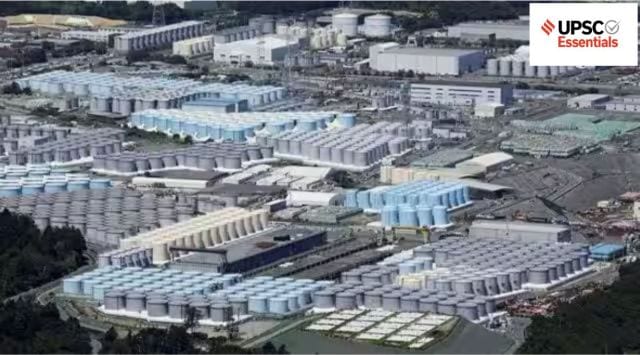© IE Online Media Services Pvt Ltd
Latest Comment
Post Comment
Read Comments
 Brush up your knowledge of Environment, Geography, Science and Technology by solving the MCQs. Here is the aerial view that shows the tanks containing treated radioactive wastewater at the Fukushima Daiichi nuclear power plant in Fukushima, northern Japan (AP Photo)
Brush up your knowledge of Environment, Geography, Science and Technology by solving the MCQs. Here is the aerial view that shows the tanks containing treated radioactive wastewater at the Fukushima Daiichi nuclear power plant in Fukushima, northern Japan (AP Photo) 🚨 This story is part of our special initiative for UPSC and other competitive exams. Look out for UPSC KEY on weekdays and UPSC Essentials everyday, Weekly news express with MCQs, Key Terms of the past week, quizzes as well as The Indian Express 360° Upsc Debate, Society & Social Justice, UPSC Mains Practice, Art and Culture with Devdutt Pattanaik, UPSC Ethics Simplified, Experts Talk, and more. 🚨
UPSC Essentials brings to you its initiative of subject-wise quizzes. These quizzes are designed to help you revise some of the most important topics from the static part of the syllabus. Each day, we will cover one new subject. Attempt today’s subject quiz on Environment, Geography, Science and Technology to check your progress. Come back tomorrow to solve the Economy Quiz.

With reference to the desalination plants, consider the following statements:
1. The technology used in the process is natural osmosis.
2. The cost of setting up and running a desalination plant is very low.
3. Desalination is largely practiced in Middle Eastern countries.
How many of the statements given above are correct?
(a) Only one
(b) Only two
(c) All three
(d) None
With reference to the Advanced Liquid Processing System (AEPS), consider the following statements:
1. It is a filtration system used to treat radioactive water.
2. It can remove all radioactive contaminants from the water except deuterium.
Which of the statement(s) given above is/are not correct?
(a) 1 only
(b) 2 only
(c) Both 1 and 2
(d) Neither 1 nor 2
Consider the following statements regarding the Indian squirrels: (PYQ 2023)
1. They build nests by making burrows in the ground.
2. They store their food materials like nuts and seeds in the ground.
3. They are omnivorous.
How many of the above statements are correct?
(a) Only one
(b) Only two
(c) All three
(d) None
Consider the following pairs:
| Convention | Description |
| Basel Convention | Chemical and Pesticide-related International trade. |
| Rotterdam Convention | Controlling the Transboundary Movement of Hazardous Waste. |
| Minamata Convention | Developing global legally binding instruments on mercury. |
| Rio de Janeiro Convention | Protecting Human Health and the Environment from Persistent Organic Pollutants (PoP). |
How many of the pairs given above are correctly matched?
(a) Only one
(b) Only two
(c) Only three
(d) All four
Consider the following:
1. Carbon capture and storage
2. Solar radiation modification
3. Ecosystem-based mitigation
How many of the above are the approaches for removing excessive greenhouse gases in the atmosphere?
(a) Only one
(b) Only two
(c) All three
(d) None
FYI:
— A desalination plant converts salt water into potable water. These plants are generally located in regions where there is access to seawater.
— The most often used method for the process is reverse osmosis, which uses an external pressure to drive solvents from a high-solute concentration area to a low-solute concentration area across a membrane. Hence, statement 1 is not correct.
— The microscopic pores in the membranes allow water molecules through but leave salt and most other impurities behind, releasing clean water from the other side.
— Desalination has largely been limited to affluent countries in the Middle East and has recently started making inroads in parts of the United States and Australia. Hence, statement 3 is correct.
— In India, Tamil Nadu has been the pioneer in using this technology, setting up two desalination plants near Chennai in 2010 and then 2013.
— Desalination is an expensive way of generating drinking water as it requires a high amount of energy. The other problem is the disposal of the byproduct — highly concentrated brine — of the desalination process. Hence, statement 2 is not correct.
Therefore, option (a) is the correct answer.
FYI:
— Several reactors at the nuclear power plant melted down after the 2011 earthquake and tsunami. Since then, workers at the now-defunct plant have been cooling the reactors by using water, which becomes contaminated.
— Japan is using a filtration system called the Advanced Liquid Processing System (ALPS) which can remove all radioactive contaminants from the water except tritium. Hence, statement 1 is correct.
— Tritium is a form of hydrogen that occurs naturally in the Earth’s atmosphere and is part of water itself. So it isn’t possible to create a filter to separate it from the contaminated water. Hence, statement 2 is not correct.
— According to Tokyo Electric Power Company Holdings (TEPCO), to tackle the situation, it will dilute the contaminated water using seawater to ensure that the concentration levels of tritium are well below the safety standards.
Therefore, option (b) is the correct answer.
FYI:
— The Indian palm squirrel or three-striped palm squirrel (Funambulus palmarum) is a species of rodent in the family Sciuridae that includes small or medium-sized rodents found naturally in India.
— Indian palm squirrel is a very adaptable species. It is active during the day (diurnal animal) and semi-arboreal.
— Indian palm squirrel is an omnivore. Hence, statement 3 is correct.
— Indian palm squirrels build nests in the treetops using the grass and branches. Hence, statement 1 is not correct.
— Its diet is mostly based on fruit and nuts, but it also consumes eggs, small birds, larvae and insects.
— Indian palm squirrel collects food and protects its stashes aggressively from other squirrels and birds. These squirrels store food in the treetops. Hence, statement 2 is not correct.
Therefore, option (a) is the correct answer
(Other Source: dste.py.gov.in)
FYI:
— The Earth is the only planet with an environment conducive to human life. World Environment Day is observed every year on June 5 to commemorate the sacred goal of environmental protection.
— Environmental conservation is critical to the existence of human civilisation. Massive afforestation, eco-friendly lifestyles, and the promotion of green technologies and procedures must all be seriously examined in order to minimise carbon emissions.
— There are various global conventions and treaties:
| Convention | Description |
| Basel Convention | Controlling the Transboundary Movement of Hazardous Waste. |
| Rotterdam Convention | Chemical and Pesticide-related International trade. |
| Minamata Convention | Developing global legally binding instruments on mercury. |
| Rio de Janeiro Convention | Biological diversity |
| Stockholm Convention | Protecting Human Health and the Environment from Persistent Organic Pollutants (PoP). |
| Ramsar Convention | Conserving wetlands |
| Vienna Convention | To protect the ozone layer |
Therefore, option (a) is the correct answer.
FYI:
— Geoengineering and nature-based solutions have emerged as potential options to offset the global impacts of climate change and reach the temperature goals.
— Geoengineering solutions are an umbrella term for human interventions to change the climate systems. The IPCC talks about two major geoengineering approaches for removing excessive greenhouse gases in the atmosphere.
Carbon dioxide removal and Solar radiation modification
— Carbon dioxide removal approach focuses on removing greenhouse gases from the atmosphere and locking them away. It can be done through carbon capture and storage technologies (CCS). Hence, 1 is correct.
— Solar radiation modification does not affect atmospheric greenhouse gases but aims to reflect the solar radiation coming to the earth. Hence, 2 is not correct.
— The removal of the radiation modification due to the thermal inertia of the climate system could result in the escalation of temperature very quickly, giving significantly less time to adapt.
— Solar radiation can also affect natural vegetation.
Nature-based solution
— It is an umbrella term used for several solutions like green infrastructure, natural infrastructure, ecological engineering, ecosystem-based mitigation, ecosystem-based adaptation, and ecosystem-based disaster risk reduction.
— The natural systems have played a critical role in sequestering the excess carbon dioxide in the atmosphere by a simple yet miraculous process termed photosynthesis. Hence, 3 is correct.
Therefore, option (b) is the correct answer.
Daily subject-wise quiz — Polity and Governance (Week 23)
Daily Subject-wise quiz — History, Culture, and Social Issues (Week 23)
Daily subject-wise quiz — Environment, Geography, Science and Technology (Week 22)
Daily subject-wise quiz — Economy (Week 22)
Daily subject-wise quiz – International Relations (Week 21)
Subscribe to our UPSC newsletter and stay updated with the news cues from the past week.

Read UPSC Magazine